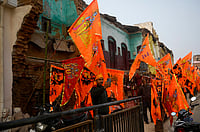Come Sunday and old Lucknow's Nakhas market, once a favourite haunt of the nawabs, throbs with life. You can get anything here: spices, clothes, furniture, utensils, antiques, plants and, yes, even live birds. Ram Avatar is a third-generation sidewalk bird seller in this bustling avian supermarket which hawks anything from ink-black ravens to rafter pigeons to wild roosters to turkeys, ducks and love birds. But his most prized and pricey bird cannot be confined in the wired cages. For that, Avatar takes you behind his shop to a garbage heap where eight pairs of Sarus cranes, the world's tallest flying bird and an endangered species banned for sale under India's stringent Wildlife Protection Act, hop around clumsily waiting for buyers. "Their wings have been clipped, so they can't fly," Avatar informs you proudly.
The hapless cranes, which the International Crane Foundation naively believes suffers "little persecution in areas dominated by the Hindu religion", barely survive on the grain the sellers scatter on the garbage dump every morning. One of them pushes his feet behind, primed for takeoff, and tries desperately. "We clipped his wings recently...he'll soon get used to not flying," says Avatar. Middlemen hustle interested buyers into the area to check these regal birds, which sell for anything between Rs 18,000-30,000. Orders also pour in through long distance calls, e-mail and fax. The customers mostly comprise rich local businessmen, and even a prominent industrialist. "Only they can afford these birds, give them enough space in their big lawns and gardens," says a bird vendor. The maimed regal bird is a fancy pet to some; others take it home as a "good omen" as the cranes symbolise fidelity (see box), even if it takes clipped wings to ensure loyalty to humans. But the cranes are quite "acclimatised" to humans, often nesting in paddy fields. So they are regarded as omen for good crops too. Other vendors insist the crane is a good guard-bird. "It's better to buy the birds when they are younger. You can train them better that way," he says. "The crane will raise an alarm if there's an intruder, give chase and sometimes even gouge out eyes."
The shocking open trade in the backstreets of Lucknow only adds to the woes of the already beleaguered bird in India. Five wetlands in UP's Etawah and Mainpuri districts are home to over 33 per cent of the 9,000-strong Sarus crane population in the world. The five wetlands—Sarsai Nawar, Garh, Sauj, Ambarpur, Kodaiya—support over 3,000 Sarus cranes. But the habitat took a big hit when these wetlands were being drained under a World Bank-funded reclamation project. (The state's wasteland development board had declared these as saline wastelands and was draining them for conversion to other uses.) This March, acting on a petition filed by the Delhi-based Wildlife Trust of India (WTI), the Allahabad High Court stopped the draining of the five wetlands. "Any further draining would render the birds homeless and force them to look for roosting sites in nearby crop fields, where they could wreak havoc. This could lead to conflicts that have historically never existed between man and this revered bird," says Aniruddha Mookerjee of WTI.
Increasing pollution has also affected the Indian Sarus crane. The great concentration of Indian Sarus cranes in the wetlands was enabled by the fact that land use practices had changed little from traditional patterns, says the International Crane Foundation. But some fear now the wetland food web on which Sarus cranes depend may be under stress as pesticides and fertilisers become more widespread in the subcontinent's rural areas. Even in India's famous Keoladeo National Park, Bharatpur, the number of Sarus nests has decreased considerably since the early 1980s.
Clearly, the court's intervention in trying to save their habitat has not been enough as the cranes are routinely smuggled into Lucknow and sold. Sellers like Ram Avatar, however, insist the trade in Sarus cranes "is no easy job". In most cases, a supplier brings the birds to the sellers. "It's a risky job both for the suppliers and poachers, and so we are paid only one per cent commission," one of them admits. Avatar has gone further and cut out the middlemen: he claims he owns a Sarus breeding farm in Malihabad, some 30 km from Lucknow. And near the Nawabganj Bird Sanctuary, situated on the Lucknow-Kanpur Highway at Unnao, rare birds are openly sold with little fear of getting caught. Sixty-odd kilometres from Lucknow, Unnao is a well-known retail bazaar for most of the birds that find their way to the Nakhas market. A certain Farid bhai sells rare birds from Unnao and has clients coming from as far as the Middle East to purchase rare game and fighter birds. "There you can get a crane pair for as less as Rs 2,000. Here they ask for Rs 15,000-20,000," says the merchant.
Bird sellers here gleefully continue with their illegal trade, the stringent Wildlife Protection Act obviously counting for little. While some appear to have the "right connections" that saves them from trouble, others seem completely ignorant of the law. Three years ago, wildlife officials confiscated some of the birds from the Nakhas market. "Finally, we had to go to the courts where we were granted a stay order and here we are!," they exclaim proudly. In 1998, Avatar himself was nabbed by the railway police and booked on charges of transporting wild animals illegally.
Local wildlife officials have turned a near-blind eye to the illegal trafficking in Sarus cranes. Dr Anil Berry, UP's chief conservator of forests (wildlife), when contacted, said: "We are shocked to hear this." He immediately ordered the conservator, Awadh region, to plan a raid on the bird market. During the raid, forest officials and their men merely sauntered from one shop to another making desultory enquiries. Spotting a Sarus crane, they chased it for a while. "How on earth do we get hold of these birds?" complained an official. "They'll attack us." Then UP's principal chief conservator, R.L. Singh, put a disarming spin on the whole episode, saying "the range officer, the sub-divisional forest officer and wildlife warden, reported that the bird-sellers were only dealing in exotic birds and that they found no cranes in the vicinity". (Under the Wildlife Protection Act, trading in endangered birds is prohibited. Traders are only allowed to deal in exotic birds of foreign origin like macaws, love-birds, African parrots, Rosellas and cockatoos.) Sudha Hansraj, founder director of People For Animals, a Lucknow-based ngo, is exhausted with her efforts to put a stop to the trade in her city. She says: "It's all a farce. Despite working so hard for the last six years, I feel I have failed to achieve anything as far as cruelty to animals go." No wonder the traders remain defiant. "I have a feeling they have some kind of backing from somewhere," says Berry. He admits the wildlife department raids so far have been carried out only in fits and starts.
It's now evident that another round of raids will not deter the determined Sarus crane sellers of Lucknow. "As long as there is a demand for these birds, we will be around," says one. Add to this the lax enforcement of laws, and saving the Sarus crane is turning out to be a flight of fantasy.
The No Fly Zone
Endangered Sarus cranes are openly sold as pets in Lucknow's bird markets even as wildlife officials conduct half-hearted raids

The No Fly Zone
The No Fly Zone
Published At:
MOST POPULAR
WATCH
MORE FROM THE AUTHOR
×


















